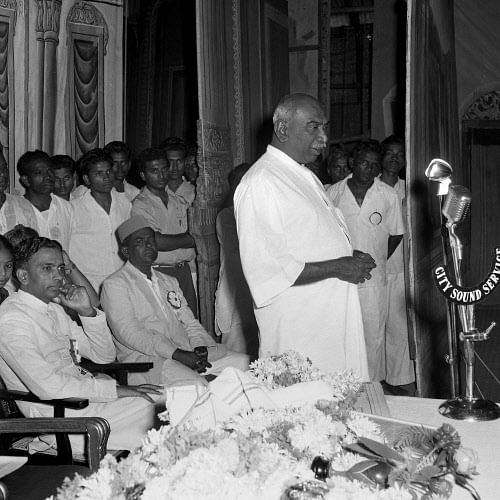
K Kamaraj was born on July 15, 1903, in Virudhunagar, Tamil Nadu, in a poor household to Kumaraswami Nadar and Sivakami Ammal.
His name was originally Kamatchi, later changed to Kamarajar. A sixth-grade school dropout, Kamaraj became a part of the Congress when he was 18 years old. Active in the freedom movement, he took part in many protests including the Non-Cooperation Movement and the Nagpur Flag Satyagraha.
In 1927, Kamaraj started the Sword Satyagraha in then Madras and was chosen to lead the Neil Statue Satyagraha, which was given up later for the Simon Commission boycott.
Kamaraj went to jail for two years for participating in the Salt Satyagraha, led by Rajagopalachari at Vedaranyam, and again for a year, in 1932, for holding processions and demonstrations in Virudhunagar, under Section 144, which was imposed in Madras prohibiting meetings and processions against the arrest of Gandhi in then Bombay.
At 34, Kamaraj entered the Assembly and won the Sattur seat in the 1937 election. By 1946, he became the President of the Madras Provincial Congress Committee and on October 9, 1963, he became President of the Indian National Congress. Kamaraj or 'Kingmaker', as he was known in the party, served as Tamil Nadu chief minister for three consecutive terms from 1954-1963.
He introduced the Midday Meal Scheme in the 1960s to provide at least one meal a day to lakhs of schoolchildren. Kamaraj strived to eradicate illiteracy by introducing free and compulsory education up to the 11th standard. He reformed the education system by expanding the number of working days and changing the syllabus to include more ability-based knowledge. Kamaraj and Bishnuram Medhi (Governor) took efforts to establish IIT-Madras in 1959.
In 1963, Kamaraj suggested to Jawaharlal Nehru that senior Congress leaders should leave ministerial posts to take up more organisational work. This became the 'Kamaraj Plan'. Six union ministers and six chief ministers, including Lal Bahadur Shastri, Jagjivan Ram, Morarji Desai, Biju Patnaik and SK Patil, resigned from their posts.
After Nehru's death in 1964, he refused to become the prime minister and brought in two other prime ministers - Lal Bahadur Shastri in 1964 and Nehru's daughter Indira Gandhi in 1966.
Kamaraj was known for his simplicity, quick wit, political intelligence and known to be incorruptible. On his 116th birth anniversary, here are a few rare pics of the political stalwart:
and Kerala Minister Achyutan in Bangalore. (File Image)
Congress leaders watching Khedda operation at forest area in Mysore district of Madras Presidency.
(Photo: Prajavani, T L Ramaswamy)
Congress leader K Kamaraj presents photo Album to S N Mrs Nijalingappa
and Nagappa Alva present on the occasion. (Photo: T L Ramaswamy, Prajavani)
at congress workers meeting in Bangalore. (Photo: Prajavani, T L Ramaswamy)
Kollur Mallappa, G V Hallikeri and other local leaders present on the occasion. (DH File Photo)
Bangalore City district Congress Committee in Bangalore. (Photo: T L Ramaswamy, Prajavani)
conference organised by KPCC, K S Hegde former Justice supreme court and others were
seen on the dais.
AICC President K Kamaraj at Vidhanasoudha in Bangalore. (DH File Photo)
a function in Bangalore. Education Minister S R Kanthi and Union minister Lal Bahaddur Shastry
present on the occasion. (DH File Photo)
AICC president K Kamaraj at Mysore Working Journalist Association in Bangalore. (DH File Image)
Tamil Nadu chief minister and president of the Indian National Congress K Kamaraj. (DH File Photo)